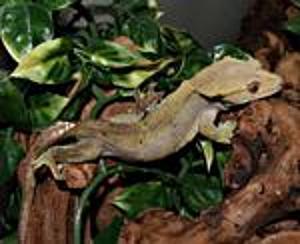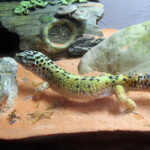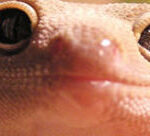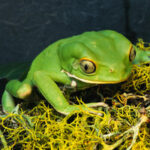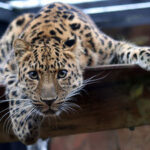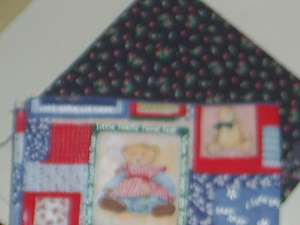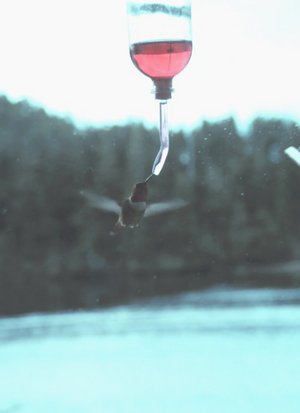There are many different species of geckos, but few are easy to handle and are well tempered. The two most popular species are the leopard and crested (or eyelash) gecko. Both are easily bred in captivity. Of the two, the crested gecko, live in a more humid environment and its adhesive lamellae (sticky feet) allow it to stick to nearly everything and even hang upside down to the amusement of its caretaker. Be warned, however, because the crested gecko also has frog-like jumping abilities and will end up hanging on the wall or even the ceiling if you’re not careful! Overall, the crested gecko is easy to care for and, with proper care, can live for up to ten or more years.
Housing the Crested Gecko:
An adult crested gecko generally grows from around five to eight inches and has a stocky build. Younger geckos are fine in a 10-gallon aquarium and several adult geckos can be housed together in a 20-gallon. If you choose to house more than one, make sure they are the same size, have plenty of places to hide and that only one is a male. Since cresteds are arboreal (tree dwellers), the tank should be tall, rather than long, with leaves and branches (artificial are easy to clean and maintain, but be sure they’re non-toxic) draped from ceiling to floor, along with other branches for the gecko can climb on. There should also be plenty of hiding places for during the day.
The geckos will spend most of their time off the ground. Because they are nocturnal, they will return to the bottom of the tank to feed at night. A variety of substrates can be used, including reptile mulches, aspen shavings, orchid bark or even paper towels. It’s also important to keep the humidity at 50-80 percent. Try adding some sphagnum moss to hold in extra moisture as you experiment with humidity.
The tank should be kept between 75 and 85 degrees during the day and can fall as low as 68 degrees at night. A full-spectrum light should be provided for 10-12 hours a day to aid in proper absorption of vitamin D. Unlike other geckos, the setup doesn’t require an overhead heat lamp, but an under the tank heating pad or low-watt heat lamp can be used if the tank isn’t warm enough. Red and blue heat lights can provide a great way to view geckos at night. They can’t see the light and it’s a perfect time to witness them hopping from branch to branch and stalking insects.
Feeding the Crested Gecko:
Speaking of insects, the crested gecko will eat a variety of things, most of which are alive. Crickets are a good source of nutrition (make sure to gut load them by feeding them nutritious grains and fruits/veggies and to dust with calcium right before feeding). Geckos will also eat meal, phoenix and wax worms, though the latter is high in fat and should only be an occasional treat. Fruit based baby food is also well received and can be offered every other day. It’s best mixed with calcium or even crested gecko food (available at most pet shops). A good rule of thumb is to offer live food no larger than the gecko’s head. Also, provide a small dish of fresh water daily.
Finally, there are a few additional things to keep in mind. A gecko’s skin is very delicate, and while the crested can be handled, it’s best to do so only for short periods of time. The gecko’s skin will also turn almost silvery at times when it’s about to shed (juveniles shed more frequently than adults). This is perfectly normal, but avoid handling the gecko during the shed. Also, despite its relatively prehensile tail, never grab the gecko (or any lizard) by its tail, as they have the ability to drop them when over-stressed. The tail will not regenerate as it does with the leopard gecko.
Reference:
- “Crested Gecko Care Sheet” found on www.petco.com/caresheets/lizards/Gecko_Crested.pdf ; “Captive Care and Breeding of the New Caledonian Crested Gecko” found on www.kingsnake.com/rockymountain/RMHPages/RMHcrested.htm “Crested Gecko” found on www.grizzlyrun.com/Pets/Reptiles/Lizards/Geckos/Crested_Gecko/Default.htm
